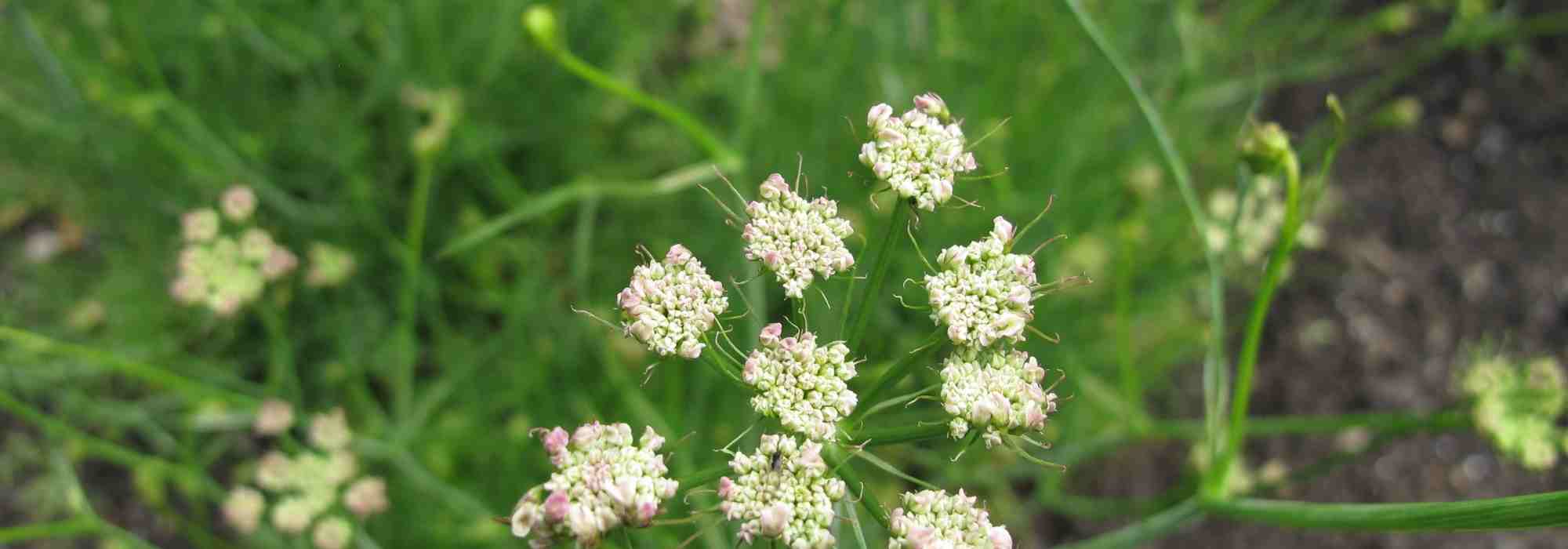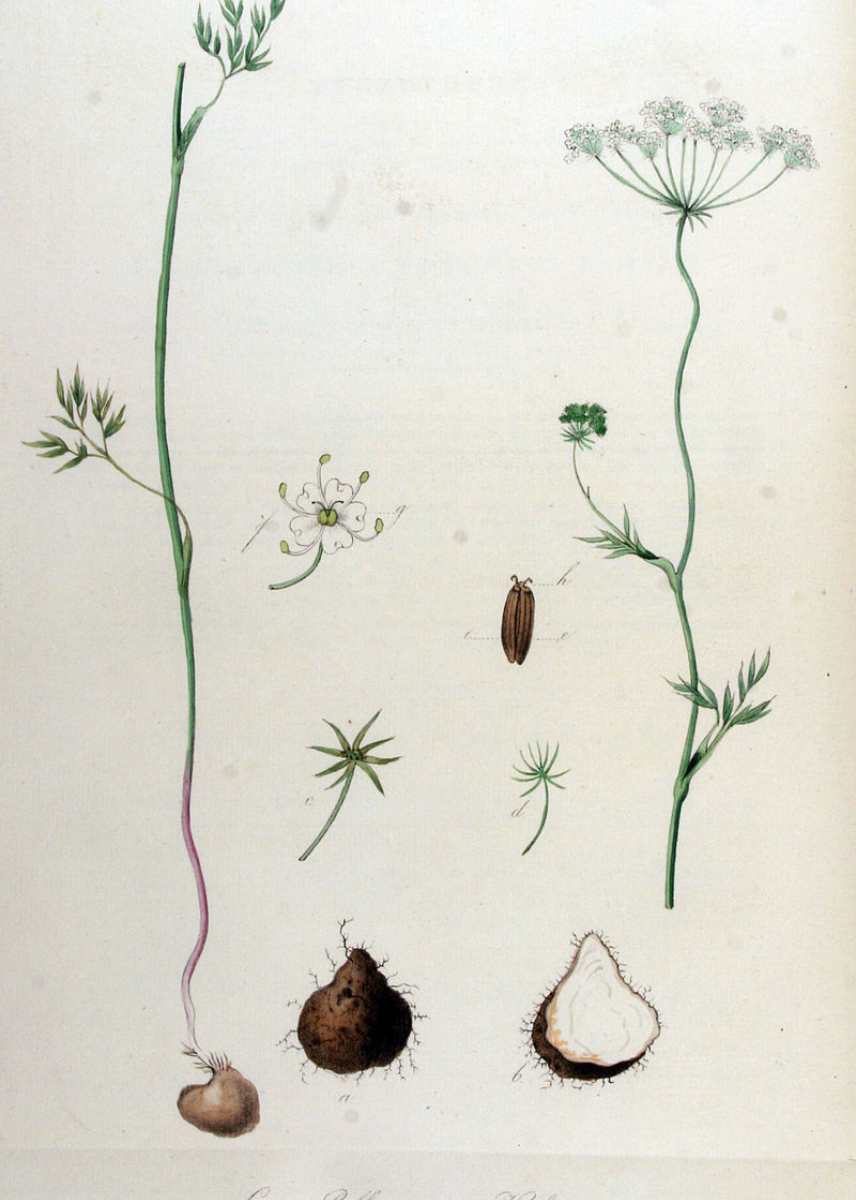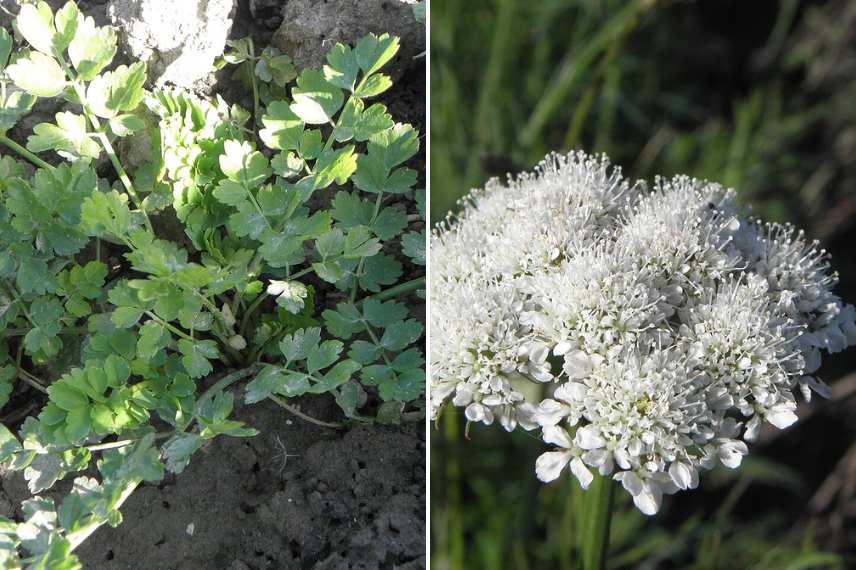
Growing Earth Chestnuts: Where, When and How?
Our tips for sowing and planting Bunium bulbocastanum
Contents
In the plant world, certain plants, once prized, fall into oblivion, overshadowed by more popular crops. This is the case with the earth chestnut (Bunium bulbocastanum), a small tubercle with a delicate hazelnut flavour, once highly valued in Europe for its taste and resilience. Gradually replaced by potatoes and other root vegetables, it is slowly making a comeback in home kitchens and gardens, though it requires some patience before you can enjoy its tubercles, leaves or seeds.
What if we restored this plant to its rightful place in our gardens? Hardy, undemanding and full of flavour, the earth chestnut deserves to be rediscovered, both for its culinary qualities and its agronomic interest. Let’s explore together the cultivation secrets of this forgotten treasure!
What exactly is this earth chestnut?
Earth chestnut (Bunium bulbocastanum) is a herbaceous perennial plant belonging to the Apiaceae family, like carrot, parsley and fennel. Native to Europe and Western Asia, it grows naturally in meadows, fields and forest edges with well-drained soil.
Morphologically, Bunium bulbocastanum forms erect stems reaching 30 to 60 cm in height, with a spread of about 40 cm. It bears finely divided leaves, cut into narrow, linear segments, resembling those of fennel or wild carrot. This light, delicately aromatic foliage is inserted on thin, glabrous stems, very branched and upright. It is evergreen to semi-evergreen depending on the region, and can be consumed like parsley.
Flowering occurs in summer, usually between June and July, producing umbel-shaped inflorescences with a slightly downy appearance, composed of small white flowers typical of the Apiaceae family. Highly melliferous, these flowers attract numerous pollinators, including bees and butterflies, which contribute to the plant’s reproduction.

Botanical plate of the earth chestnut (© Jan Kops – Wikimedia Commons)
The most prized part of Bunium bulbocastanum is its tubercle, a swollen root rounded to slightly elongated in shape, brownish on the outside and white inside. This 1 to 2 cm diameter tubercle is rich in starch and aromatic oils, giving it a sweet flavour reminiscent of chestnut, potato and hazelnut. Unlike other edible tubers, its growth is relatively slow and it develops deep underground, making it sometimes difficult to harvest.
Finally, the earth chestnut produces elongated brown seeds, which ensure the reproduction of the species. These seeds, in addition to their role in dispersal, have long been used as a spice, their aroma resembling that of black cumin (Nigella sativa).
Sowing seeds or planting tubercles?
Sowing Bunium bulbocastanum is a propagation method that yields a large number of young plants, but requires patience due to slow germination, and its unpredictable success rate. To hope to taste earth chestnuts, one must wait for the tubercles to develop, which can take several years. Nevertheless, it’s a method that produces many young plants at low cost, while promoting genetic diversity and adaptation to local soil and climate conditions.
Planting tubercles is the quickest and most effective method for growing earth chestnuts. Indeed, the plant develops faster this way, and the first harvest of tubercles occurs as early as the second year. As for the success rate, it’s significantly higher since tubercles are less sensitive to extreme conditions during early growth.
Where and how to plant the earth chestnut?
Planting tubercles or young plants should be done in humus-rich soil, well worked to be loosened, perfectly drained, and preferably moist. Do not hesitate to amend the soil with well-rotted compost or decomposed manure. Ideally, the soil should be clayey or calcareous, but acidic or poor soils should be avoided as they would hinder the growth of the earth chestnut. The key is to ensure the soil is not waterlogged. If this is the case, it is recommended to add sand before planting.
As for the chosen location, it should be partially shaded in regions with scorching sun, and very sunny elsewhere.
To prevent the accumulation of soil-borne diseases and maintain good fertility, it is advisable not to replant earth chestnuts in the same spot every year. Crop rotation with leguminous plants (such as broad beans or peas) can enrich the soil with nitrogen and improve future yields.
Tubercles or young plants should be placed at a depth of about 5 to 10 cm, spaced 20 to 30 cm apart.

Foliage and flower of the earth chestnut
When and how to sow earth chestnuts?
Sowing Bunium bulbocastanum seeds produces robust young plants, but the process requires a great deal of patience.
When to sow?
The seeds should be sown in spring, from February to June, or in autumn, from September to October, ideally after a cold stratification period of about 4 to 6 weeks to improve their germination rate.
How to sow?
Sowing can be done directly in the ground or, preferably, in trays or boxes filled with a light, well-draining substrate rich in organic matter. A special sowing compost is ideal. The sowings should be placed in a cool, sheltered spot. When sowing directly in the ground, it is recommended to space the seeds about 20 cm apart and cover them with a thin layer of soil. Germination may take several weeks, or even months. Watering should be regular but moderate to keep the substrate moist.
The young plants, once strong enough, should be pricked out into buckets before being transplanted into the ground in autumn or the following spring.
Planting takes place during the same periods, either in early spring, between March and May, or in autumn, in September or October, when the soil is still loose but not waterlogged.
What care does the earth chestnut require?
Once the tubercles of Bunium bulbocastanum are planted, minimal but regular maintenance is necessary to ensure good growth and optimal production. Here are the key aspects to monitor:
Watering: Finding the Right Balance
The earth chestnut prefers fresh but well-drained soil. Moderate watering is essential, especially during dry spells. Too much moisture can cause the tubercles to rot, while overly dry soil slows their development. The ideal approach is to water when the soil begins to dry on the surface, taking care not to saturate the earth.
Weeding: Reducing Competition
As the growth of Bunium bulbocastanum is relatively slow, competition from adventive plants can hinder its development. Regular manual weeding or hoeing helps limit this competition without damaging the young shoots. Using an organic mulch (dead leaves, straw, wood chips) also helps suppress weed growth while retaining soil moisture.
Fertilisation: Light and Natural Inputs
The earth chestnut is not a particularly demanding plant, but well-enriched soil improves its growth. A layer of mature compost or well-rotted manure at the start of the season is usually sufficient. A light potassium boost (wood ash, natural fertiliser) can encourage tubercle development. Avoid excess nitrogen, which promotes foliage at the expense of the roots.
Protection Against Pests and Diseases
The earth chestnut is relatively disease-resistant but can be prone to rot in poorly drained soil. It is therefore essential to avoid excess moisture and ensure good soil aeration. Rodents (voles, field mice) can also be a problem, as they are fond of the tubercles. A thick mulch or underground barriers (fine mesh) can help minimise damage.
Letting the Foliage Dry Naturally
At the end of the growing cycle in autumn, the foliage turns yellow and dries naturally. It is best to leave it in place until completely withered, as it continues to nourish the tubercles. Once dry, it can be cut and used as mulch or added to compost.
Harvesting and Storing the Earth Chestnut
To harvest your first earth chestnut tubers, patience is key. You’ll need to wait at least two years, or even three, before digging them up for your first harvest. It’s important to wait until the vegetative cycle is fully complete to allow the tubers to reach their optimal size and store well after harvesting. Harvesting too early would result in smaller, less developed tubers.
Harvesting Bunium bulbocastanum tubers usually takes place in autumn, when the foliage turns yellow and dries out—a sign that the plant is entering dormancy. This typically occurs between September and November, depending on the climate and growing conditions.
An interesting feature of earth chestnuts is that you can harvest the tubers as needed, leaving some roots in the ground. This allows the plant to continue producing in subsequent years, provided you don’t dig up everything.
How to harvest the tubers?
Harvesting should be done carefully to avoid damaging the tubers, which are relatively fragile and can break if handled roughly. Here’s the recommended method:
- Gently loosen the soil around the plant using a garden fork or a hand fork. It’s best to start slightly away from the plant to avoid cutting through the tubers.
- Lift the root ball carefully, shaking off excess soil to expose the tubers.
- Collect the tubers by hand, taking care not to crush or bruise them. The tubers often grow in clusters beneath the main plant.
- Lightly brush off clinging soil, but avoid washing the tubers immediately if you plan to store them. A simple brushing or quick wipe with your hand is enough.
How to store the tubers?
Fresh tubers can be eaten straight away, but if you wish to store them, it’s best to keep them in a cool, dry, and dark place. Storing them in a cellar or in slightly damp sand can extend their shelf life for several months.
To prevent drying out, the tubers should not be kept in overly dry conditions. Conversely, excessive moisture can lead to mould or rot.
- Subscribe!
- Contents
































Comments